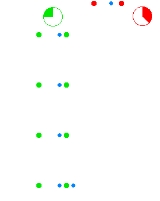
Inhomogeneous electromagnetic wave equation
Overview
Maxwell's equations
Maxwell's equations are a set of partial differential equations that, together with the Lorentz force law, form the foundation of classical electrodynamics, classical optics, and electric circuits. These fields in turn underlie modern electrical and communications technologies.Maxwell's equations...
can be written in the form of a inhomogeneous electromagnetic wave equation
Electromagnetic wave equation
The electromagnetic wave equation is a second-order partial differential equation that describes the propagation of electromagnetic waves through a medium or in a vacuum...
(or often "nonhomogeneous electromagnetic wave equation") with sources. The addition of sources to the wave equations makes the partial differential equations inhomogeneous.
Maxwell's equations in a vacuum with charge
 and current
and current  sources can be written in terms of the vector and scalar potentials as
sources can be written in terms of the vector and scalar potentials as

where

and
 .
.If the Lorenz gauge condition
Lorenz gauge condition
In electromagnetism, the Lorenz gauge or Lorenz gauge condition is a partial gauge fixing of the electromagnetic vector potential. The condition is that \partial_\mu A^\mu=0...
is assumed

then the nonhomogeneous wave equations become

 .
.In cgs units these equations become


with


and the Lorenz gauge condition
 .
.For Lorentz–Heaviside units, sometimes used in high dimensional relativistic calculations, the charge and current densities in cgs units translate as

 .
.The relativistic Maxwell's equations
Formulation of Maxwell's equations in special relativity
The covariant formulation of classical electromagnetism refers to ways of writing the laws of classical electromagnetism in a form which is "manifestly covariant" , in the formalism of special relativity...
can be written in covariant
Covariance and contravariance
In multilinear algebra and tensor analysis, covariance and contravariance describe how the quantitative description of certain geometric or physical entities changes with a change of basis from one coordinate system to another. When one coordinate system is just a rotation of the other, this...
form as




where J is the four-current
Four-current
In special and general relativity, the four-current is the Lorentz covariant four-vector that replaces the electromagnetic current density, or indeed any conventional charge current density...
 ,
,
is the 4-gradient
Four-gradient
The four-gradient is the four-vector generalization of the gradient:\partial_\alpha \ = \left...
and the electromagnetic four-potential
Electromagnetic four-potential
The electromagnetic four-potential is a potential from which the electromagnetic field can be derived. It combines both the electric scalar potential and the magnetic vector potential into a single space-time four-vector. In a given reference frame, the first component is the scalar potential and...
is




with the Lorenz gauge condition
 .
.Here
 is the d'Alembert operator
is the d'Alembert operatorD'Alembert operator
In special relativity, electromagnetism and wave theory, the d'Alembert operator , also called the d'Alembertian or the wave operator, is the Laplace operator of Minkowski space. The operator is named for French mathematician and physicist Jean le Rond d'Alembert...
.
The electromagnetic wave equation is modified in two ways in curved spacetime, the derivative is replaced with the covariant derivative
Covariant derivative
In mathematics, the covariant derivative is a way of specifying a derivative along tangent vectors of a manifold. Alternatively, the covariant derivative is a way of introducing and working with a connection on a manifold by means of a differential operator, to be contrasted with the approach given...
and a new term that depends on the curvature appears (SI units).

where

is the Ricci curvature tensor.
Unanswered Questions

